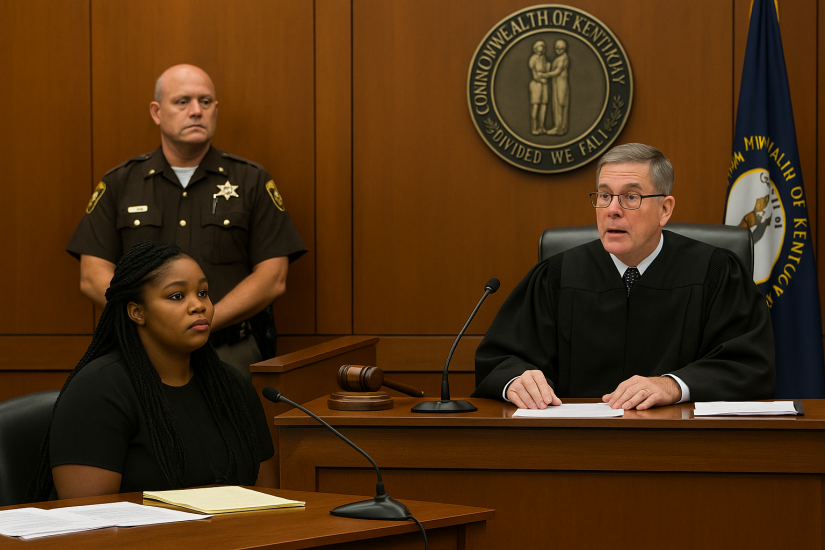Is Justice Being Staged? Inside the Courtroom Where Breonna Taylor’s Fate is Decided

In the heart of Louisville, Kentucky, the courtroom is charged with tension. The public awaits with bated breath as sentencing begins for the officers involved in the shooting death of Breonna Taylor. Amid the deeply emotional atmosphere surrounding the case, a surprising angle has come into focus: the very courtroom itself. Has the construction and staging of this legal venue influenced public perception and the course of justice?
Breonna Taylor’s tragic case, unfolding since her death on March 13, 2020, remains an emblematic moment in America’s ongoing struggle with racial justice and police accountability. The sentencing now underway is the culmination of years of activism, protests, and legal battles. Yet, critics and activists alike are raising concerns that justice may not only depend on facts and testimony but also the physical environment where the legal drama plays out.
A Symbolic Venue
The courtroom hosting the sentencing proceedings is not just any room—it’s been carefully constructed with an eye for symbolism and authority. The interior features stately wood-paneled walls, an elevated judicial bench, prominent state symbols, and austere furnishings meant to communicate impartiality and gravitas. But, amid ongoing debates about racial bias within the justice system, some wonder if this meticulous arrangement of judicial symbolism serves more as theater than as a stage for impartial justice.
“Every aspect of this courtroom—from the elevated positioning of the judge to the flags positioned behind the bench—is deliberately designed to reinforce authority,” explains Dr. Amanda Yates, a legal historian specializing in courtroom architecture. “The question we’re facing is whether these architectural choices inadvertently convey biases or preconceptions about power dynamics that influence jury perception.”
Influence or Impartiality?
Critics argue that such staging can subconsciously shape the perceptions of jurors, attorneys, and even the public watching the proceedings unfold. The elevation of the judge symbolizes judicial superiority, potentially affecting how jurors interpret the judge’s reactions and instructions. Meanwhile, the stark arrangement and decorum may impact the emotional tenor of testimonies, subtly affecting case outcomes.
Conversely, legal experts supporting traditional courtroom arrangements contend that these environments promote respect for the judicial process. “The careful design is meant to underscore the seriousness of court proceedings,” says Louisville legal analyst Marcus Reed. “Justice demands reverence and impartiality, and courtrooms have evolved to reflect that need.”
Courtroom as Theater
While Breonna Taylor’s sentencing is being watched closely around the world, some activists argue that this courtroom’s construction exacerbates the spectacle, diverting attention from core issues of systemic racism and police accountability. Local activist Carla Jordan states plainly, “People are so focused on the drama unfolding within these four walls, they’re overlooking broader systemic injustices that need to be addressed.”
Jordan further argues that the courtroom, with its meticulously arranged symbols of power, contributes to a form of “performative justice,” where symbolism might overshadow substantive action. She emphasizes the need for a deeper examination of institutional reform beyond the courtroom’s walls.
The History and Symbolism
The Louisville courtroom itself has a storied past. Constructed in the mid-20th century, the space has hosted high-profile cases involving civil rights and social justice issues for decades. Its wood-paneled walls, heavy mahogany furniture, and carefully placed flags and insignia were intended to convey the stability and fairness of the legal system during turbulent times.
Yet, as America confronts renewed questions of racial justice and police reform, some experts believe the historical symbolism embedded in these spaces needs reconsideration. Dr. Yates notes, “We are in a moment where people question symbols of authority more critically. The courtroom should reflect contemporary values of fairness, equity, and transparency.”
The Psychological Impact
Psychologists emphasize the subconscious impact of environment and setting on decision-making. Dr. James Holloway, a psychologist who studies the intersection of psychology and law, suggests that courtroom architecture could subtly reinforce biases. “Humans are sensitive to environmental cues,” Dr. Holloway explains. “The elevated judge, the austere furnishings, and even the solemn atmosphere can inadvertently reinforce stereotypes or biases jurors might hold.”
Given that the Taylor case centers around themes of police authority and accountability, the visual reinforcement of power within the courtroom might unintentionally skew jury perspectives.
Calls for Change
As Breonna Taylor’s sentencing continues to unfold, the calls for systemic change grow louder. Advocates suggest that reevaluating courtroom architecture might be part of the larger conversation about judicial fairness and transparency. Some propose alternative designs, such as circular arrangements that minimize hierarchical visuals, potentially fostering a more equitable atmosphere.
Activist Carla Jordan notes, “Justice shouldn’t be something that’s merely performed in a grand, intimidating setting. It should be authentic, reflective of our collective values and striving for equity.”
Conclusion: A Question of Justice
The sentencing proceedings for the officers involved in Breonna Taylor’s death not only represent a critical moment in America’s ongoing reckoning with racial injustice—they also raise profound questions about the symbolic and psychological power of the spaces in which justice is served.
Is the carefully constructed courtroom a neutral arena of justice, or does it reinforce power imbalances and inadvertently influence outcomes? As the nation watches closely, this question—once overlooked—is now impossible to ignore. The answer may ultimately determine not only the fate of those directly involved but also how justice is pursued and perceived in America for generations to come.